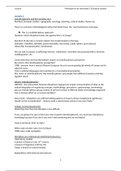Lectures Philosophy of the Humanities 2 (European Studies)
Lecture 1
Interdisciplinarity and the narrative turn
Rumford: European studies = geography, sociology, planning, cultural studies, history etc.
There is a common methodological notion that binds these: the ‘constructiveness of Europe’.
This is a multidisciplinary approach
Question: which discipline frames the agenda/who’s in charge?
Rumford: ES also ahs a common object: the transformations of Europe.
Examples: mobilities, hybridity, governmentality, risk society, public sphere, post national,
citizenship, Europeanization, borderlands.
We can add: European, (conflicting) memory, nationalism, minorities and postcolonialism, diversity,
multilingualism, etc.
Constructiveness and transformations require an interdisciplinary perspective
But what is this interdisciplinary perspective?
1988 – present: from a merely Western European focus to encompassing the whole of Europe and its
adjacent zones
From a national (languages and countries) to a transnational perspective
But: multi- or interdisciplinary? Not interdisciplinary, just people from different branches working
together (Snel)
What is interdisciplinarity?
UNESCO: “the interactions between disciplines ranging form simple communication of ideas to the
mutual integration of organizing concepts, methodology, procedures, epistemology, terminology,
data an interdisciplinary group consists of persons trained in different fields of knowledge organized
into a common effort on a common problem”.
Steve Fuller: “disciplines are artificial holding patterns of inquiry whose metaphysical significance
should not be overestimated ... inquiry needs a special space where it can roam freely.”
Critique of interdisciplinarity:
Mastering more than one discipline is too difficult.
If you are going to be part of the team who research interdisciplinarity, you must have disciplinary
knowledge because if you don’t you won’t add something and are not helpful.
Long on pretense, short on rigor!
White male scholars had a lot of critique
1980s were really outspoken.
Disciplines are continuously redefining themselves:
Take literary studies
A branch of history in the 19th century
A branch of linguistics until the 70s.
Today: a branch of cultural studies
Explanations: both internal and external.
1
,Lectures Philosophy of the Humanities 2 (European Studies)
Internal reason: Was it all wrong in the 19 th c. ? no it was not; it was the way to do it at that time. But
this changed. Changed because many aspects of literature could not be explained this way.
External reasons; stuff happens out there in society. Feminism, postcolonialisms e.g.
Turns in the humanities (and social sciences)
Transformations in and across disciplines no paradigm shift.
No fundamental transformation in these turns, less dramatic.
These turns are not paradigm shifts, because nor radical change, but exchange, interchange.
This week: the narrative turn. The nature and effect of story and storytelling, examples:
Psychology: narrative identity thesis.
Law : narrative aspects of confessions, closings
Medical: illness narratives
Management theory : ‘the story of a product or a company’
Why start with narrative?
Not just an object to be interpreted and analysed. But also a way of interpreting and evaluating. Not
just events reconstructing, but narrative.
one of the main tools to investigate the way sources are representing reality and creating
meaning.
Short history of narrative analysis
Ancient rhetoric: attention for tropes and argumentation structures (19 th c. : historicization)
Begins with formalism (e.g. Russian Formalism). And Structuralism (e.g. Czech structuralism)
Text-immanent: You only look at text itself, exclude context
Difference between sujet and fabula.
Fabula: the underlying chronological order.
Sujet: events as they are presented in the text.
Each folk tale has its own synchronic arrangement. All folk tales hold common patterns – diachronic-
which can be systemically studies.
Bal’s analysis of Rembrandt’s Susanna and the Elders
Example of: interdisciplinarity and narrative turn
Beginning pages of Bal: Why and how she evolved from someone studying the deep structures in text
to someone studying the gender aspects.
Meaning is constructed, we make it while watching
The object (as well as the spectator) is transformed.
Traditional art criticism: fabula and sujet
Discusses figurative paintings. Mostly in terms of what story does it tell, or retell?
Susanna and the Elders: how rape is averted
(book of Daniel) provides the fabula, the painting the sujet.
Traditional question: voyeurism: is Susanna ‘appealing to or enticing the spectator?’
2
,Lectures Philosophy of the Humanities 2 (European Studies)
She first does text immanent and discusses the various layers?
Art criticism: spectatorship
Narratology: adds (here internal) focalization
*painting*
The peculiar gaze of the man: hidden story level in the fabula.
Mise en abyme: a mirror image of the painting as a whole, a commentary about the act of watching.
In reality he would be attracted by the curls of Susana. Since it is a depiction for reality, he is
fascinated by the curls of Susana.
Interdisciplinarity: narratology helps to refine the visual model – Bal: “the internalizing view of
women as pure victims”, as the painting ‘undermines the naturalness of the situation”.
If you can read the paintings and see that it is not confirming to the stereotypes about this female
depiction, then that is a positive thing. (?)
The fabula (Rembrandt’s version) constructs a wholly new version of the story/sujet there is no
‘source’, meaning is constructed as we are watching.
The result is ongoing transformation of the meaning of the object.
And constructivism (Rumford): meaning is created (constructed) right here and now, while we watch,
analyse; traditions are not given but constantly recreated, they are performed.
Lecture 2
The Spatial Turn: geography and the humanities
Steve Reich: Different Trains 1988
Speech melody
Minimal music
19th c.: historicity: time became central to the methodologies of the human sciences
20th c.: spatiality: space became important in all knowledge areas
e.g.:
Gaston Bachelard: La pétique de l’espace, 1958, writes about the lied experience of architecture,
mostly of the house.
Walter Benjamin’s: passagenwerk (Arcades project)
Le Flâneur, the Stroller.
Interdisciplinarity: merging of social sciences (geography, psychology) and humanities
Happened with the rise of spatiality.
Definition spatiality: Warf (2009): ‘the insistence that no social or cultural phenomenon can be torn
from its spatial context, that geography is not some subordinate afterthought to history in the
construction of social life, that no meaningful understanding of how human beings produce and
reproduce their worlds can be achieved without invoking a sense that the social, the temporal, the
intellectual, and the personal are inescapably always and everywhere also the spatial.’
3
,Lectures Philosophy of the Humanities 2 (European Studies)
the spatial turn in the humanities.
Constructiveness of space: methodological problem, actual or metaphorical.
Are we only allowed, methodologically, to study experienced space?
Bruno Latour
Bruno Latour: ‘when things strike back’ 1999
revisits the distinction between natural sciences and soft sciences.
Soft sciences can only talk about that what is a representation of something.
Latour says that distinction between hard reality out there and soft sciences is maybe not that hard.
Object: something that can object, that can contradict. Not something that is out there.
Thing: - Latin res and causa – also mean ‘an assembly of a judicial nature gathering around a topic
that creates both conflict and assent.’
Latour: distinction between object and thing is not that hard.
We don’t know where these ‘things’ precisely begin, whether they have an ending, what their shape
is…
Philosophy traditionally distinguishes between:
Primal qualities: the stuff out of which nature is made : particles, strings, atoms, genes, etc.
And
Secondary qualities: the way people define this same universe subjectively.
Materiality
Video: Materiality: language is not so much an obstacle here: but it functions as a ‘thing’, an ‘object’
between the three men (and the boat?). all three men speak a different language and don’t
understand each other?? (ik denk van wel maar lol)
What do we mean by materiality? – by the thingness of the thing?
language and language space are the example in the video.
Etienne Balibar
Leerssen: Europe as a borderland
Etienne Balibar: border zones are vital of a new European demos, a space made up of citizenship.
Balibar makes a distinction between these two.
Paradoxes: originating in our understanding of space:
To discuss the possibility of European unification, is at the same time discussing the impossibility of
unification.
‘The Balkans are both inside and outside Europe’. So disintegrating and integrating in the EU. Says
Balibar. This has to do with the nature of borders. Need to know how borders work. Again discussion
about space because borders. Cannot draw a line and what is in the line belongs together.
Balibar: If you want to understand Europe as a continent if you look at the precise, actual nature of
the border?
4
, Lectures Philosophy of the Humanities 2 (European Studies)
If you look closely at principle of borders, this is what diversity is.
Balibar the more diverse, the more European.
Borders zones: actual border zones (Balkan, Baltic, Mediterranean), but also the postcolonial cities.
“citizenship of borders”
Extension of demos, for historically, demos was only reserve for the dominant etnos-communities
(nation states).
Second text seminar
Limen = border (Latin)
Liminality ( concept from anthropology, instrumental in re-thinking the centre-periphery opposition
( in literary studies, history, geography, sociology etc.)) centre = more mainstream society. And
periphery can be war etc. ?
Connection between these two is based on rituals.
Blindness of the centre for the periphery?
Balibar: border zones – cities and border areas – are liminal spaces, with a history – and a future? –
of potentially non-national communities.
Anthropology contains a rich literature about seemingly immobile centres and the continuous change
at the peripheries Arnold van Gennep (Rites de Passage, 1908)
Lecture 3
Film ghost dog:
Forms of (imagined) community: etnos (or demos)
Memory
Language
Illustration of isoglosses
Freud
Memory individual psychoanalysis: repressed memories as a source of mental illness.
First sources of studying memories are dealing with illness and trauma. Freud shifted in 20s, when he
wrote ground-breaking books which tried to adapt his ideas of psychoanalysis to the society as a
whole. He became a cultural analyst, rather than only a social analyst.
Das Unbehagen in der Kultur 1929 tries to make sense of the psyche of a society. He started off by
focusing on the single person, and later studied the city of Rome. If you want to visualize what
human memory looks like, you have to think of Rome because it is one of the most famous places
where you can see historical time visualized. You can see all of the layers of history there. Digging like
archaeologists leads you to older layers. He dismisses his own metaphor, because it doesn’t work for
one fundamental reason: fundamentals of human psyche.
Spatial Nebeneinander
Temporal: nacheinander.
Maurice Halbwachs
- Sociologist
- Followed up on work of Freud etc. but gave radical twist.
- Came up with notion of collective memory.
5





